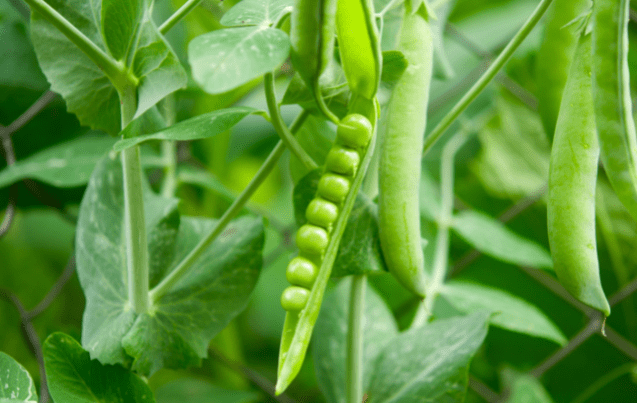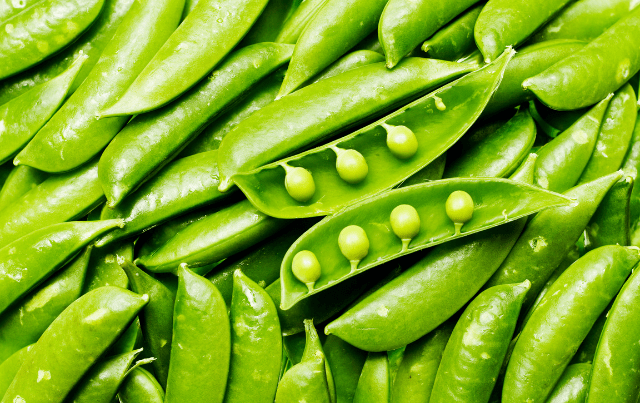Can Dogs Eat Peas? Are These Tiny Vegetables Good for Them?

Those little balls of goodness manage to find themselves in many of our favorite dishes. Curries, risottos, pasta – they’re everywhere (including our cupboards and freezers). But can dogs eat peas too? Are they good for them? What about all the different varieties?
Keep reading to find out what you need to know about feeding peas to your doggo.
Can Dogs Eat Peas?
The simple answer is yes. Dogs can eat peas. In fact, many of the best fresh dog food brands add these nutritious little veggies to their food for vibrancy and texture. There are a couple of things you need to be aware of before feeding your pup peas.
Are Peas Good for Dogs?
Little peas are full of protein and fiber which are good for your pup’s muscles and digestive system. They also contain vitamins A, C, and K and minerals such as magnesium, iron, and phosphorus.
Because peas themselves are small, and we don’t recommend feeding huge amounts to your pup, the realistic benefits of giving peas to your dog are minimal. But there’s certainly no harm in giving a few green peas to your pup for variety!
Your dog’s diet should be well balanced and they should be getting the vast majority of their nutrients from their regular dog food.

Can Dogs Eat Frozen Peas?
It’s OK to give your dog frozen peas, but it’s best for you to cook them first (mainly for texture for your pooch). If you do decide to give your dog peas that have been frozen make sure they’re not frozen with anything else such as butter or a sauce. Sauces and butter contain lots of salt and fat – which our pets definitely don’t need in their diet.
Can Dogs Eat Canned Peas?
Canned peas are a staple in many people’s store cupboards. But unlike canned dog food, canned peas aren’t something you should be giving to your dog. Most canned peas contain a lot of salt and extra additives to preserve them. It’s best to stick to fresh garden peas for pups.
Can Dogs Eat Sugar Snap Peas?
Sugar Snap peas are a good source of vitamins K, A, and B. They also contain potassium, iron, fiber, and zinc. These can help with your dog’s eye health, skin, heart, and digestion.
These snappy peas can be quite fibrous, though. So it’s best to cut them up into bite-size pieces to avoid them becoming a choking hazard.

Can Dogs Eat Snow Peas?
Snow peas are softer than sugar snaps and are also safe for your dog to eat. They don’t provide your pup with a huge amount of nutrients, so it’s best to give them to your pooch occasionally. Giving too many peas to your pup may cause them to have diarrhea and even lead to kidney disease.
What About Pea Pods? Can Dogs Eat Those?
The general rule to follow is that if humans eat them, so can pups (when it comes to pea pods). For example, we normally eat snow pea pods, so these are OK to feed to your dog. Garden peas are almost always shelled and the pods are not very pleasant to eat. We’d therefore advise only giving your doggo the peas themselves.
When Shouldn’t You Feed Peas to Your Dog?
Dogs with kidney problems shouldn’t really be eating peas. Peas contain purines, a kind of compound that is converted into uric acid. Healthy dogs can process uric acid through their kidneys, however pups with kidney problems won’t be able to and if the levels of this acid are too high, it may cause kidney issues such as kidney stones.
Whilst feeding peas to your dog can be a healthy low-calorie snack (especially for overweight pups looking to lose a few pounds), too many peas can cause digestive problems such as diarrhea, nausea, and vomiting.

How Should You Feed Peas to Dogs?
Dried peas (such as chickpeas etc) should always be cooked before feeding them to your pup. Hard peas that haven’t been cooked are difficult to digest and may cause chewing or tooth problems.
You should also avoid giving your dog canned peas because they contain lots of added salt.
Here are a couple of good ways of adding peas to your pup’s diet.
- Pure and simple! Why not try giving your dog English peas as a healthy treat? They’re great for training sessions and certainly healthier than other processed dog treats.
- Add them to dog food. Lots of dogs like a bit of variety when it comes to their diet (of course, some really don’t too)! Try adding a couple of raw or cooked, fresh peas to their regular dog food. They might like the change in texture and color.
- Whisk them up in a pupsicle. Dogs love having something to lick and chew on on a hot day. Try whisking up some peas with a bit of broccoli and natural yogurt and freezing it for a refreshing snack.
- Stuff a toy! Nearly all pooches love having something to play with, especially when there’s something yummy inside for them to lick out! There are many puzzle toys and indestructible toys (for heavy chewers) that can be stuffed with pea puree or another food. They’re a great way to keep your dog entertained and happy.
How Many Peas Should Dogs Be Eating?
Fresh or frozen peas can be a great and healthy snack for your doggo to eat. But, too much of a good thing can cause some problems.
It’s best to stick to the 10/90 rule. Dogs should be getting 90% of their daily nutrition from specially formulated dog food. The extra 10% can be healthy human snacks such as shrimp, asparagus, Brussels sprouts, and celery.
It’s best to avoid giving your beloved pooch too many overly processed treats (however good they smell to them). They’re full of lots of extra carbohydrates that doggos don’t need.
So, Can Dogs Eat Peas?
Yes, dogs can eat peas when they’re prepared correctly. They shouldn’t, however, eat too many peas.
Fresh veg can be a great replacement for other snacks and treats. The low carb count plus a couple of added nutritious benefits make them a generally healthier option. You should avoid canned peas and dried peas which contain additives and are hard to digest.
The most important thing is to ensure you’re feeding your dog a well-rounded, nutritious, and delicious diet. When they’re getting the vitamins, minerals, and nutrients they need from their main food, you can top up their diet with yummy, healthy human treats too!
